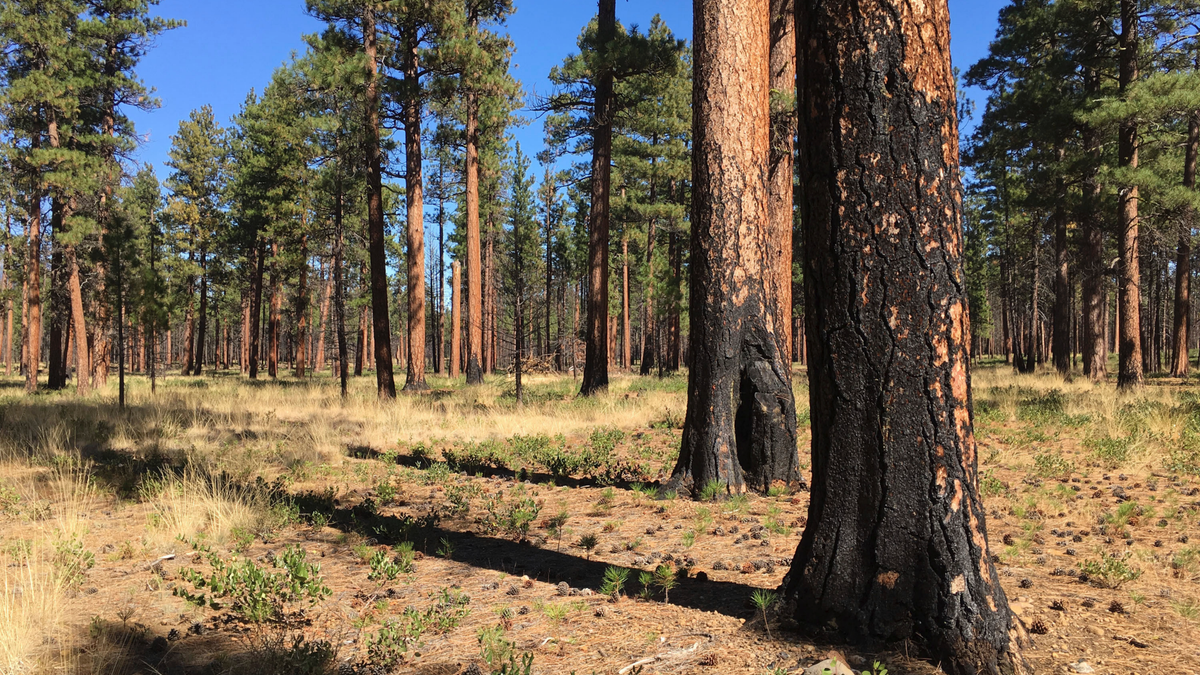
FILE - This Sept. 27, 2017, file photo, shows charred trunks of Ponderosa pines near Sisters, Ore., months after a prescribed burn removed vegetation, smaller trees and other fuel ladders last spring. Creating fire buffers between housing and dry grasslands and brush and burying spark-prone power lines underground would give people a better chance of surviving wildfires, experts say. So would controlled burns, a proven, historic practice that has been neglected in recent decades. (AP Photo/Andrew Selsky, File)
BILLINGS, Montana – Creating fire buffers between housing and dry brush, burying spark-prone power lines and lighting more controlled burns to keep vegetation in check could give people a better chance of surviving wildfires, according to experts searching for ways to reduce growing death tolls from blazes in California and across the U.S. West.
Western wildfires have grown ever more lethal, a grim reality driven by more housing developments sprawling into the most fire-prone grasslands and brushy canyons, experts say. Many of the ranchers and farmers who once managed those landscapes are gone, leaving terrain thick with vegetation that can explode into flames.
That's set the stage for tragedy, as whipping winds, high temperatures and drought that are characteristic of climate change stoke wildfires like those raging in Northern and Southern California, killing at least 59 people in recent days with 130 others missing.
Hundreds of thousands of people were told to evacuate ahead of the blazes. Some experts say there has been an over-reliance on evacuation and too little attention paid to making communities safe, plus not enough money for preventive measures.
Search crews found many victims inside or next to their vehicles, killed trying to flee. Survivors of the blaze that nearly obliterated the Northern California town of Paradise spoke of having minutes to escape and narrow roads rendered impassable by flames and traffic jams.
There are "so many ways that can go wrong, in the warning, the modes of getting the message out, the confusion," said Max Moritz, a wildfire specialist with the University of California Cooperative Extension program.
Moritz urged consideration of the creation of community "retreat zones" where residents can ride out deadly firestorms if escape seems impossible. That could be a community center, built or retrofitted to better withstand wildfires that can top 2,000 degrees Fahrenheit and reduce ordinary homes to ash.
Such fire protection can include sprinklers, fire- and heat-resistant walls and roofs, and barriers to keep sparks out of chimneys and other openings, according to the International Code Council, a nonprofit that helps develop U.S. building codes.
Creating more buffers around housing developments would help stave off wildfires. They could be parks or irrigated agriculture, like the vineyards that helped keep last year's wildfires in California wine country from spreading into even more towns.
Also helpful would be burying electric power lines, which can spark and fail in high winds that drive many of California's fiercest fires, said Jon Keeley, a research scientist with the U.S. Geological Survey in California.
Sparks from utility equipment are suspected in the Northern California wildfire that consumed Paradise, destroying thousands of homes.
A proven method to guard against destructive fires is controlled burns. By intentionally lighting fires when conditions are right, property owners remove low-lying trees and brush that otherwise act as fuel.
In the mid-20th century, California ranchers burned hundreds of thousands of acres annually to manage their lands, said Lenya Quinn-Davidson, director of the Northern California Prescribed Fire Council.
That was phased out in the 1980s after California's fire management agency took over the burns. By last decade, the burned acreage dropped to less than 10,000 acres annually, Quinn-Davidson said.
Agricultural land surrounding many towns became overgrown, and housing developments pushed deeper into rural areas. Such was the case with the Northern California town of Redding ahead of a fire that began in July and destroyed more than 1,000 homes. It was blamed for eight deaths.
"You get these growing cities pushing out — housing developments going right up into brush and wooded areas. One ignition on a bad day, and all that is threatened," Quinn-Davidson said. "These fires are tragic, and they're telling us this is urgent."
The recent California fires set off a debate over what's to blame. President Donald Trump claimed in a tweet Saturday that "gross mismanagement of the forests" was the sole reason the state's fires had become so "massive, deadly and costly." He also threatened to withhold federal payments.
But most of California's recent deadly fires are in grasslands and brushy chaparral — not thick forest, Keeley said. "Thinning isn't going to change anything," he said.
Trump's assertion also ignored the huge federal land holdings in the state. It brought a quick backlash from the president of the California firefighters union, who described it as a shameful attack on thousands of firefighters.
To ease tensions, the White House sent Interior Secretary Ryan Zinke to tour fire-damaged areas. Zinke struck a conciliatory tone and offered assistance in a meeting with California Gov. Jerry Brown.
"We need to work in unison to make sure we thin the forest, especially fire breaks, and make sure we have prescribed burns," Zinke told The Associated Press. "There's been a lack of management on Interior lands, on U.S. Forest Service lands and certainly with state lands."
California, not the Trump administration, is putting more money behind such efforts. In September, Brown signed a law providing $1 billion over five years for fire protection, including more controlled burns and tree clearing.
Federal spending on hazardous fuels reduction has been flat in recent years, hovering just under $600 million, even as direct firefighting costs jumped to a record $2.9 billion last year.
For 2019, the Forest Service has proposed a $3 million bump for its wildfire fuels program. At Interior, Zinke proposed a $29 million cut in fuel management spending.
___
Knickmeyer reported from Washington.
___
Follow Matthew Brown on Twitter at https://twitter.com/MatthewBrownAP .

